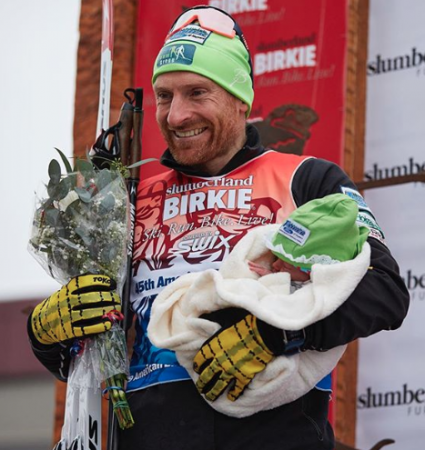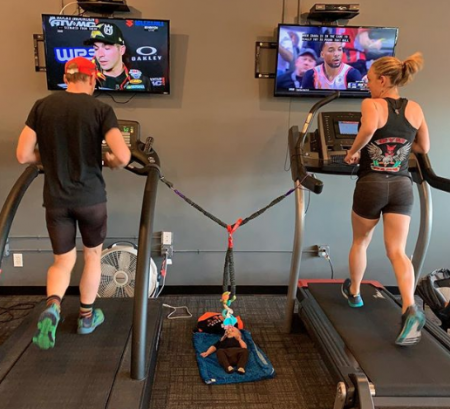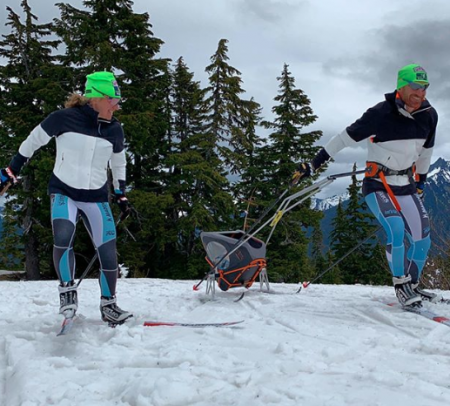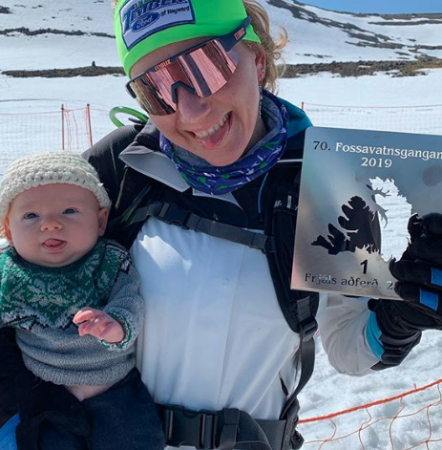The “First Tracks” series highlights the pregnancy, postpartum, and parenting experiences of noteworthy athletes in cross-country skiing in various stages of their professional careers. The sharing of these experiences can benefit athletes in any stage of their career, whether they are an elite or recreational skier, by demonstrating that it is very possible to return to skiing, competition, and an active lifestyle with a growing family. The series will include the physical challenges of being an athlete during and after pregnancy, balancing family life with skiing, and the joy that starting a family can bring. You can read Part 1 of Caitlin’s story here.

Heidi Mowgli Gregg was born February 5th, 2019. Caitlin’s mind did shift toward recovery and getting back to training, but not immediately.
“Honestly, I was so grateful that the delivery went well. I think I had so much fear about delivering on the blood thinners that once that went by I was in such a good place and so excited.”
Brian was only able to take five days off surrounding the delivery, then needed to go back to work full-time, but Caitlin still received plenty of support in her transition to new motherhood.
“I was really lucky because my mother-in-law came and she stayed with us for three weeks in the beginning, which was awesome.”
Brian’s mother helped round the clock, helping Caitlin get the rest and care that she needed. Caitlin recounted that it was particularly special to have her help since her own mother had passed away in the fall of 2017. After her mother-in-law left, Caitlin’s closest friend from high school flew out to offer her continued support for a couple of additional weeks.
She felt further supported by the women in the local ski community.
“All of the moms in our ski community stepped up and everyone brought meals and little tidbits of advice. That was incredible. I feel very lucky that I had such good support and I think that was key.”
As her body healed, Caitlin felt the itch to begin exercising again but did her best to temper her enthusiasm.
“After the blood clot and I felt confident that I could train, I was able to do a lot of activity for the majority of my pregnancy. But after the delivery, I was really, really encouraged by a lot of people – athletes, non-athletes, my strength coach – to be patient in coming back.”

For the first five weeks, Caitlin only went for short walks and otherwise rested and spent time with Heidi. During that time, they cheered for Brian while he raced to second place in the Birkie. While the weeks passed quickly, she struggled with the change of pace.
“For me, the hardest part about recovery was for sure being patient and sitting still for five weeks. But at the same time, you have a new baby and everything is so exciting.”
During that time, she continued to use her FitSplint, no longer to support her large belly during training, but as the postpartum core is like a deflated balloon, the band helped make up for the loss in stability during her walks and general movement.
“I wore [the FitSplint] for the first couple of weeks walking and I thought it was really helpful to be there when I knew that my abs weren’t quite ready yet to be supporting my body and as things were transitioning and shifting after the delivery.”
As Heidi arrived at the peak of an incredible winter for skiers in the Midwest, it was hard for Caitlin not to test the waters and get back on her skis.
“It was probably the snowiest February we’ve had in Minnesota, so all the natural snow trails were open and the skiing was awesome. I remember Brian said, ‘Oh my gosh, let’s go out for a ski.’”
She was leery of how her newly postpartum hips and loose core would handle skiing but decided the conditions were too good to pass up.

“We went out and literally five minutes into the ski, I was like, ‘This is too much. I feel like Jell-O, this is just not fun,’” she laughed. “So we took a bunch of pictures and went home, and I waited another month or more before trying to ski again.”
Before jumping into heavy training, Caitlin prioritized rehabilitating her core and pelvic floor muscles so her body could function and move properly before being under heavy stress. She began following a program from the MUTU System, which focused on pelvic floor stabilization, and reactivating and strengthening her core from the inside outward. As she progressed through the program, she gradually added other types of training back in.
“I started lifting again at about six weeks, and I walked, and then I was able to start skiing again, and the skiing felt so good. Then, I was very patient with the running and would walk-run, so walk for five minutes then run for a minute and gradually increase until I could do a mile, then a couple of miles.”
While advice for high-level training during pregnancy is limited, more information on athletic recovery is becoming available. Caitlin expressed gratitude for the active women and professional athletes who have spoken out about the challenges with postpartum recovery and how to overcome them and was grateful to learn from both their successes and failures.
“I had great advice and resources [for recovery]. From reading about Marit Bjorgen who maybe came back a little bit too quickly when she did start training again and had two pelvic stress fractures, I knew that calcium was super important. And I read that when you’re breastfeeding, you’re more at risk for gestational osteoporosis.”
Overall, Caitlin was happy with the steps she took to return to training and competing and believes that being conservative, patient, and addressing the underlying small insufficiencies that can create larger problems down the road.
“On the flip side, you’re now a mom and you have a lot of things going on. So there were times when I was like, ‘Wow, I feel really good, but I am WAY more busy than I was before.’”
As far as the conversation about goals for the future, Caitlin described an open-minded approach. They are thrilled with their new addition to the family, but finding time to fit in training full-time is a juggling act. In the mornings, a shared nanny comes to their house to take Heidi from 6:30 until 11:30. During that time, Caitlin is working for the Loppet Foundation leading and training with the Loppet Nordic Racing collegiate program.

In the afternoons, Team Gregg tries to include Heidi in their afternoon sessions. Sometimes she is in the gym with them – Caitlin endearingly called her as a “gym rat” – and sometimes she joins them on a run. These sessions look different than before, but she enjoys including Heidi in their lifestyle.
“Maybe you start lifting and she starts fussing. So then you go and take a little break. You hang out with her, and maybe you nurse, or you bounce her around, or you show her the mirror. Or sometimes, she’s your weight and you’re doing goblet squats with Heidi – she thinks it’s hilarious. You find ways to be super creative.
“We took on this concept where we didn’t know what our lives would be like after Heidi came, so we really dove in with trying to make it kind of an adventure with Heidi,” she continued. “Again, following Kikkan and Holly and other moms we saw, they were bringing their kids out for ski adventures or hikes, so that was something that we were looking forward to.”

The Greggs partnered with a Bend, OR based company called KidRunner who designed a revolutionary chariot-style running stroller. Recently, professional runner Lyndy Davis and fellow KidRunner ambassador clocked a time of 1:21:38 to set the Guinness Book of World Records fastest half-marathon while towing a hands-free stroller. It also has ski attachments, allowing Heidi to join them in the winter as well.
“One of our favorite things to do has been to go on a big family run or adventure and bring Heidi. She’s done it either on Brian’s chest, or in the KidRunner, and we’ve been able to bring her into the mountains and all over, which has been really fun.”
These sessions look different than before, but Caitlin describes Heidi as an easy-going and happy baby who has so far loved joining them, even for 20 plus mile runs with Brian.
“So we’ve been trying to do what we did before, except we both have jobs and we have Heidi, which means we don’t get nearly enough sleep,” she concluded with a laugh. “But it’s pretty fun.”
In early May, when Heidi was just three months old, the Gregg Family headed to Iceland to race the 25-kilometer freestyle and the 50 k classic two days later at the Fossavatn Ski Festival.
Apart from racing so soon postpartum, Caitlin felt trepidation around the idea of international travel with a three-month-old.
“I was kind of on the fence about Iceland. It seemed like a really fun adventure, but then right before, I got really nervous about what we were about to undertake.”
Because they were trying to accommodate Brian’s work schedule, they had left Minneapolis on a red-eye flight Tuesday night, arriving midday Wednesday in Iceland then racing Thursday.
“I’d say the one thing that I completely didn’t think about was that we had a three-month-old, so we weren’t going to sleep at all the night before the flight, and then I was sort of used to, ‘Okay, maybe you don’t get a great night sleep on the plane.’ But we were entertaining a newborn on the plane, so we had no sleep for two days. We were absolute zombies.”
Unsure of how to navigate the child-care aspect of racing internationally, Caitlin reached out to her family.
“The biggest thing that helped was that we had my sister come.”
Her sister, who lives in southern California, tried skiing for the first time that winter while visiting a pregnant Caitlin in Minneapolis. Caitlin explained that while her sister was excited to try skiing again and to spend time with Heidi while they raced, she also wanted to check out some of the tourist destinations in Iceland, like the Blue Lagoon. The foursome headed to the hot springs shortly after their arrival to Iceland.
“So we went to the Blue Lagoon where Brian and I proceeded to just pass out and fall asleep,” she laughed. “And my sister was like, ‘What is wrong with them?’”
The power nap seemed to be effective as Caitlin went on to win the 25 k skate race the next day.
“I think there is a lot of adrenaline [at races] and I had been skate skiing all winter, so I actually felt really good in the skate race,” she said.

She also took third in the classic marathon, though she did not feel as strong there. Despite the lack of sleep and stress of international travel with an infant, which she felt they underestimated, she and Brian enjoyed racing with different expectations and tried to laugh about the hilarity of their situation rather than dwell on how exhausting and challenging it was.
“All in all, I thought we did awesome,” she laughed as she thought back on the trip overall. “I will say it changed my entire perspective on sleep before a race or time-management before a race.”
Since the Fossavatn, Caitlin has enjoyed hopping into a few running races and will continue to do so as she trains for the 2020 Birkie.
“I think my attitude has been that everything now is new PR’s. Maybe I’ll never hit the same level as I was at before being a mom, but everything now is like, ‘Oh, it’s my PR as a mom.’ And I think that’s really fun, and a good way for me not to put too much pressure on myself and have an open mind that anything can happen. Sometimes I surprise myself, and sometimes I’m like, ‘Yup. That’s not that good.'”
Caitlin has enjoyed the process of seeking out resources during after pregnancy and learning as much as she can about perinatal exercise. Rather than seeing pregnancy as a setback to her athletic career, she described the overall journey as “an exploration” and focuses on what she can learn from the experience. Her postpartum body is different and responds differently to training than before, but she doesn’t see the changes as negative.
“I think the biggest thing that I’ve noticed is that I maybe need to slow down a bit and be more aware of ‘How’s my body doing? How are my muscle imbalances?’ All of a sudden, all of these smaller details seem more important before. Maybe it’s because of all the talk about pelvic floor health and the core training, and maybe it’s because of having to take a step back and rebuild my fitness from the ground up. I think all of a sudden, the training has taken on a new challenge and a new fun element for me, so I’ve been having a really good time training. I can’t say that I go out every day and think to myself that I’m stronger or more fit than before or going to set PR’s or things like that, but it’s fun to see the subtle differences. I can’t exactly pinpoint what they are, but they’re different.”
Some days, Caitlin feels like she can tap into her “mom strength” and nail a workout, other days that is not the case, especially after a rough night of sleep. As she looks to the future, she wants to continue to enjoy the exploration or her limits, while acknowledging that her priorities are now shifted. The mobile app runs faster than the desktop version, consumes less power, is specially designed for a small smartphone screen, and takes into account the architecture of the mobile gadget. In addition, the mobile parimatch app has extensive functionality with many additional options. The mobile app has a user-friendly interface, high performance, and multilingual support.
“I’m going to be very open-minded. I’m having fun training and the majority of the time, I feel really good. At the end of the day, I want to be the best mom that I can be and lead by example for Heidi. It’s a neat challenge.”
Similar to the way Holly Brooks is becoming certified to offer coaching for expectant parents to help them emotionally prepare for the lifestyle change, Caitlin’s experience has inspired her to continue learning about pre and postnatal training with the hope of offering coaching to other female athletes that want to pursue athletic goals after pregnancy.
“I’m really fascinated about all of the prenatal and postnatal training and exercise and that I’d really like to dive in. I’m going to start doing more coaching and training, and I would really love to specialize in women who are pre and postnatal and help guide them through how I found my path with it so that they can be successful during their pregnancy and afterward and reach their goals. There’s so much out there, but it’s so hard to track it all down. I’d like to become a resource. There’s a whole world of creative solutions for all things revolving around fitness and new moms.”
Rachel Perkins
Rachel is an endurance sport enthusiast based in the Roaring Fork Valley of Colorado. You can find her cruising around on skinny skis, running in the mountains with her pup, or chasing her toddler (born Oct. 2018). Instagram: @bachrunner4646



